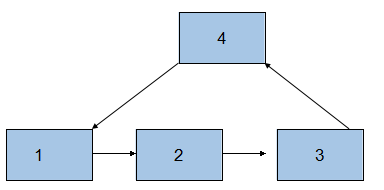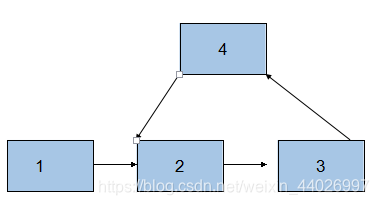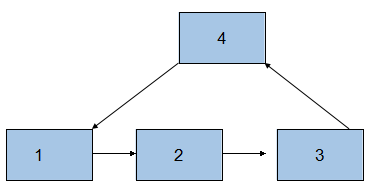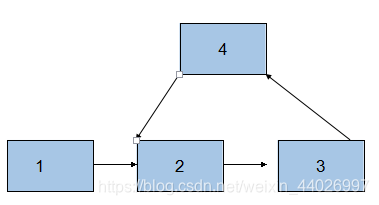链表 java实现 超详细
目录:
1、单链表的创建和遍历
2、求单链表中节点的个数
3、查找单链表中的倒数第k个结点(剑指offer,题15)
4、查找单链表中的中间结点
5、合并两个有序的单链表,合并之后的链表依然有序【出现频率高】(剑指offer,题17)
6、单链表的反转【出现频率最高】(剑指offer,题16)
7、从尾到头打印单链表(剑指offer,题5)
8、判断单链表是否有环
9、取出有环链表中,环的长度
10、单链表中,取出环的起始点(剑指offer,题56)。本题需利用上面的第8题和第9题。
11、判断两个单链表相交的第一个交点(剑指offer,题37)
1、单链表的创建和遍历:
public class LinkList {
public Node head;
public Node current;
//方法:向链表中添加数据
public void add(int data) {
//判断链表为空的时候
if (head == null) {//如果头结点为空,说明这个链表还没有创建,那就把新的结点赋给头结点
head = new Node(data);
current = head;
} else {
//创建新的结点,放在当前节点的后面(把新的结点合链表进行关联)
current.next = new Node(data);
//把链表的当前索引向后移动一位
current = current.next; //此步操作完成之后,current结点指向新添加的那个结点
}
}
//方法:遍历链表(打印输出链表。方法的参数表示从节点node开始进行遍历
public void print(Node node) {
if (node == null) {
return;
}
current = node;
while (current != null) {
System.out.println(current.data);
current = current.next;
}
}
class Node {
//注:此处的两个成员变量权限不能为private,因为private的权限是仅对本类访问。
int data; //数据域
Node next;//指针域
public Node(int data) {
this.data = data;
}
}
public static void main(String[] args) {
LinkList list = new LinkList();
//向LinkList中添加数据
for (int i = 0; i < 10; i++) {
list.add(i);
}
list.print(list.head);// 从head节点开始遍历输出
}
}
上方代码中,这里面的Node节点采用的是内部类来表示(33行)。使用内部类的最大好处是可以和外部类进行私有操作的互相访问。
注:内部类访问的特点是:内部类可以直接访问外部类的成员,包括私有;外部类要访问内部类的成员,必须先创建对象。
为了方便添加和遍历的操作,在LinkList类中添加一个成员变量current,用来表示当前节点的索引(03行)。
这里面的遍历链表的方法(20行)中,参数node表示从node节点开始遍历,不一定要从head节点遍历。
2、求单链表中节点的个数:
注意检查链表是否为空。时间复杂度为O(n)。这个比较简单。
//方法:获取单链表的长度
public int getLength(Node head) {
if (head == null) {
return 0;
}
int length = 0;
Node current = head;
while (current != null) {
length++;
current = current.next;
}
return length;
}
3、查找单链表中的倒数第k个结点:
3.1 普通思路:
先将整个链表从头到尾遍历一次,计算出链表的长度size,得到链表的长度之后,就好办了,直接输出第(size-k)个节点就可以了(注意链表为空,k为0,k为1,k大于链表中节点个数时的情况)。时间复杂度为O(n)
public int findLastNode(int index) { //index代表的是倒数第index的那个结点
//第一次遍历,得到链表的长度size
if (head == null) {
return -1;
}
current = head;
while (current != null) {
size++;
current = current.next;
}
//第二次遍历,输出倒数第index个结点的数据
current = head;
for (int i = 0; i < size - index; i++) {
current = current.next;
}
return current.data;
}
如果不允许你遍历链表的长度,该怎么做呢?
3.2 改进思路:(这种思路在其他题目中也有应用)
这里需要声明两个指针:即两个结点型的变量first和second,首先让first和second都指向第一个结点,然后让second结点往后挪k-1个位置,此时first和second就间隔了k-1个位置,然后整体向后移动这两个节点,直到second节点走到最后一个结点的时候,此时first节点所指向的位置就是倒数第k个节点的位置。时间复杂度为O(n)
public Node findLastNode(Node head, int index) {
if (node == null) {
return null;
}
Node first = head;
Node second = head;
//让second结点往后挪index个位置
for (int i = 0; i < index; i++) {
second = second.next;
}
//让first和second结点整体向后移动,直到second结点为Null
while (second != null) {
first = first.next;
second = second.next;
}
//当second结点为空的时候,此时first指向的结点就是我们要找的结点
return first;
}
上面的代码中,看似已经实现了功能,其实还不够健壮:
要注意k等于0的情况;
如果k大于链表中节点个数时,就会报空指针异常,所以这里需要做一下判断。
public Node findLastNode(Node head, int k) {
if (k == 0 || head == null) {
return null;
}
Node first = head;
Node second = head;
//让second结点往后挪k-1个位置
for (int i = 0; i < k - 1; i++) {
System.out.println("i的值是" + i);
second = second.next;
if (second == null) { //说明k的值已经大于链表的长度了
//throw new NullPointerException("链表的长度小于" + k); //我们自己抛出异常,给用户以提示
return null;
}
}
//让first和second结点整体向后移动,直到second走到最后一个结点
while (second.next != null) {
first = first.next;
second = second.next;
}
//当second结点走到最后一个节点的时候,此时first指向的结点就是我们要找的结点
return first;
}
4、查找单链表中的中间结点:
同样,面试官不允许你算出链表的长度,该怎么做呢?
思路:
和上面的第2节一样,也是设置两个指针first和second,只不过这里是,两个指针同时向前走,second指针每次走两步,first指针每次走一步,直到second指针走到最后一个结点时,此时first指针所指的结点就是中间结点。注意链表为空,链表结点个数为1和2的情况。时间复杂度为O(n)。
//方法:查找链表的中间结点
public Node findMidNode(Node head) {
if (head == null) {
return null;
}
Node first = head;
Node second = head;
//每次移动时,让second结点移动两位,first结点移动一位
while (second != null && second.next != null) {
first = first.next;
second = second.next.next;
}
//直到second结点移动到null时,此时first指针指向的位置就是中间结点的位置
return first;
}
上方代码中,当n为偶数时,得到的中间结点是第n/2 + 1个结点。比如链表有6个节点时,得到的是第4个节点。
5、合并两个有序的单链表,合并之后的链表依然有序:
例如:
链表1:
1->2->3->4
链表2:
2->3->4->5
合并后:
1->2->2->3->3->4->4->5
解题思路:
挨着比较链表1和链表2。
这个类似于归并排序。尤其要注意两个链表都为空、和其中一个为空的情况。只需要O (1) 的空间。时间复杂度为O (max(len1,len2))
//两个参数代表的是两个链表的头结点
public Node mergeLinkList(Node head1, Node head2) {
if (head1 == null && head2 == null) { //如果两个链表都为空
return null;
}
if (head1 == null) {
return head2;
}
if (head2 == null) {
return head1;
}
Node head; //新链表的头结点
Node current; //current结点指向新链表
// 一开始,我们让current结点指向head1和head2中较小的数据,得到head结点
if (head1.data < head2.data) {
head = head1;
current = head1;
head1 = head1.next;
} else {
head = head2;
current = head2;
head2 = head2.next;
}
while (head1 != null && head2 != null) {
if (head1.data < head2.data) {
current.next = head1; //新链表中,current指针的下一个结点对应较小的那个数据
current = current.next; //current指针下移
head1 = head1.next;
} else {
current.next = head2;
current = current.next;
head2 = head2.next;
}
}
//合并剩余的元素
if (head1 != null) { //说明链表2遍历完了,是空的
current.next = head1;
}
if (head2 != null) { //说明链表1遍历完了,是空的
current.next = head2;
}
return head;
}
public static void main(String[] args) {
LinkList list1 = new LinkList();
LinkList list2 = new LinkList();
//向LinkList中添加数据
for (int i = 0; i < 4; i++) {
list1.add(i);
}
for (int i = 3; i < 8; i++) {
list2.add(i);
}
LinkList list3 = new LinkList();
list3.head = list3.mergeLinkList(list1.head, list2.head); //将list1和list2合并,存放到list3中
list3.print(list3.head);// 从head节点开始遍历输出
}
6、单链表的反转:【出现频率最高】
例如链表:
1->2->3->4
反转之后:
4->3->2->1
思路:
从头到尾遍历原链表,每遍历一个结点,将其摘下放在新链表的最前端。注意链表为空和只有一个结点的情况。时间复杂度为O(n)
方法1:(遍历)
//方法:链表的反转
public Node reverseList(Node head) {
//如果链表为空或者只有一个节点,无需反转,直接返回原链表的头结点
if (head == null || head.next == null) {
return head;
}
Node current = head;
Node next = null; //定义当前结点的下一个结点
Node reverseHead = null; //反转后新链表的表头
while (current != null) {
next = current.next; //暂时保存住当前结点的下一个结点,因为下一次要用
current.next = reverseHead; //将current的下一个结点指向新链表的头结点
reverseHead = current;
current = next; // 操作结束后,current节点后移
}
return reverseHead;
}
方法2:(递归)
这个方法有点难,先不讲了。
7、从尾到头打印单链表:
对于这种颠倒顺序的问题,我们应该就会想到栈,后进先出。所以,这一题要么自己使用栈,要么让系统使用栈,也就是递归。注意链表为空的情况。时间复杂度为O(n)
注:不要想着先将单链表反转,然后遍历输出,这样会破坏链表的结构,不建议。
方法1:(自己新建一个栈)
//方法:从尾到头打印单链表
public void reversePrint(Node head) {
if (head == null) {
return;
}
Stack<Node> stack = new Stack<Node>(); //新建一个栈
Node current = head;
//将链表的所有结点压栈
while (current != null) {-
stack.push(current); //将当前结点压栈
current = current.next;
}
//将栈中的结点打印输出即可
while (stack.size() > 0) {
System.out.println(stack.pop().data); //出栈操作
}
}
方法2:(使用系统的栈:递归,代码优雅简洁)
public void reversePrint(Node head) {
if (head == null) {
return;
}
reversePrint(head.next);
System.out.println(head.data);
}
总结:方法2是基于递归实现的,戴安看起来简洁优雅,但有个问题:当链表很长的时候,就会导致方法调用的层级很深,有可能造成栈溢出。而方法1的显式用栈,是基于循环实现的,代码的鲁棒性要更好一些。
8、判断单链表是否有环:
这里也是用到两个指针,如果一个链表有环,那么用一个指针去遍历,是永远走不到头的。
因此,我们用两个指针去遍历:first指针每次走一步,second指针每次走两步,如果first指针和second指针相遇,说明有环。时间复杂度为O (n)。
//方法:判断单链表是否有环
public boolean hasCycle(Node head) {
if (head == null) {
return false;
}
Node first = head;
Node second = head;
while (second != null) {
first = first.next; //first指针走一步
second = second.next.next; second指针走两步
if (first == second) { //一旦两个指针相遇,说明链表是有环的
return true;
}
}
return false;
}
完整版代码:(包含测试部分)
这里,我们还需要加一个重载的add(Node node)方法,在创建单向循环链表时要用到。
LinkList.java:
public class LinkList {
public Node head;
public Node current;
//方法:向链表中添加数据
public void add(int data) {
//判断链表为空的时候
if (head == null) {//如果头结点为空,说明这个链表还没有创建,那就把新的结点赋给头结点
head = new Node(data);
current = head;
} else {
//创建新的结点,放在当前节点的后面(把新的结点合链表进行关联)
current.next = new Node(data);
//把链表的当前索引向后移动一位
current = current.next;
}
}
//方法重载:向链表中添加结点
public void add(Node node) {
if (node == null) {
return;
}
if (head == null) {
head = node;
current = head;
} else {
current.next = node;
current = current.next;
}
}
//方法:遍历链表(打印输出链表。方法的参数表示从节点node开始进行遍历
public void print(Node node) {
if (node == null) {
return;
}
current = node;
while (current != null) {
System.out.println(current.data);
current = current.next;
}
}
//方法:检测单链表是否有环
public boolean hasCycle(Node head) {
if (head == null) {
return false;
}
Node first = head;
Node second = head;
while (second != null) {
first = first.next; //first指针走一步
second = second.next.next; //second指针走两步
if (first == second) { //一旦两个指针相遇,说明链表是有环的
return true;
}
}
return false;
}
class Node {
//注:此处的两个成员变量权限不能为private,因为private的权限是仅对本类访问。
int data; //数据域
Node next;//指针域
public Node(int data) {
this.data = data;
}
}
public static void main(String[] args) {
LinkList list = new LinkList();
//向LinkList中添加数据
for (int i = 0; i < 4; i++) {
list.add(i);
}
list.add(list.head); //将头结点添加到链表当中,于是,单链表就有环了。备注:此时得到的这个环的结构,是下面的第8小节中图1的那种结构。
System.out.println(list.hasCycle(list.head));
}
}
9、取出有环链表中,环的长度:
我们平时碰到的有环链表是下面的这种:(图1)
上图中环的长度是4。
但有可能也是下面的这种:(图2)

此时,上图中环的长度就是3了。
那怎么求出环的长度呢?
思路:
这里面,我们需要先利用上面的第7小节中的hasCycle方法(判断链表是否有环的那个方法),这个方法的返回值是boolean型,但是现在要把这个方法稍做修改,让其返回值为相遇的那个结点。然后,我们拿到这个相遇的结点就好办了,这个结点肯定是在环里嘛,我们可以让这个结点对应的指针一直往下走,直到它回到原点,就可以算出环的长度了。
//方法:判断单链表是否有环。返回的结点是相遇的那个结点
public Node hasCycle(Node head) {
if (head == null) {
return null;
}
Node first = head;
Node second = head;
while (second != null) {
first = first.next;
second = second.next.next;
if (first == second) { //一旦两个指针相遇,说明链表是有环的
return first; //将相遇的那个结点进行返回
}
}
return null;
}
//方法:有环链表中,获取环的长度。参数node代表的是相遇的那个结点
public int getCycleLength(Node node) {
if (head == null) {
return 0;
}
Node current = node;
int length = 0;
while (current != null) {
current = current.next;
length++;
if (current == node) { //当current结点走到原点的时候
return length;
}
}
return length;
}
完整版代码(包括测试部分)
public class LinkList {
public Node head;
public Node current;
public int size;
//方法:向链表中添加数据
public void add(int data) {
//判断链表为空的时候
if (head == null) {//如果头结点为空,说明这个链表还没有创建,那就把新的结点赋给头结点
head = new Node(data);
current = head;
} else {
//创建新的结点,放在当前节点的后面(把新的结点合链表进行关联)
current.next = new Node(data);
//把链表的当前索引向后移动一位
current = current.next; //此步操作完成之后,current结点指向新添加的那个结点
}
}
//方法重载:向链表中添加结点
public void add(Node node) {
if (node == null) {
return;
}
if (head == null) {
head = node;
current = head;
} else {
current.next = node;
current = current.next;
}
}
//方法:遍历链表(打印输出链表。方法的参数表示从节点node开始进行遍历
public void print(Node node) {
if (node == null) {
return;
}
current = node;
while (current != null) {
System.out.println(current.data);
current = current.next;
}
}
//方法:判断单链表是否有环。返回的结点是相遇的那个结点
public Node hasCycle(Node head) {
if (head == null) {
return null;
}
Node first = head;
Node second = head;
while (second != null) {
first = first.next;
second = second.next.next;
if (first == second) { //一旦两个指针相遇,说明链表是有环的
return first; //将相遇的那个结点进行返回
}
}
return null;
}
//方法:有环链表中,获取环的长度。参数node代表的是相遇的那个结点
public int getCycleLength(Node node) {
if (head == null) {
return 0;
}
Node current = node;
int length = 0;
while (current != null) {
current = current.next;
length++;
if (current == node) { //当current结点走到原点的时候
return length;
}
}
return length;
}
class Node {
//注:此处的两个成员变量权限不能为private,因为private的权限是仅对本类访问。
int data; //数据域
Node next;//指针域
public Node(int data) {
this.data = data;
}
}
public static void main(String[] args) {
LinkList list1 = new LinkList();
Node second = null; //把第二个结点记下来
//向LinkList中添加数据
for (int i = 0; i < 4; i++) {
list1.add(i);
if (i == 1) {
second = list1.current; //把第二个结点记下来
}
}
list1.add(second); //将尾结点指向链表的第二个结点,于是单链表就有环了,备注:此时得到的环的结构,是本节中图2的那种结构
Node current = list1.hasCycle(list1.head); //获取相遇的那个结点
System.out.println("环的长度为" + list1.getCycleLength(current));
}
}
如果将上面的104至122行的测试代码改成下面这样的:(即:将图2中的结构改成图1中的结构)
public static void main(String[] args) {
LinkList list1 = new LinkList();
//向LinkList中添加数据
for (int i = 0; i < 4; i++) {
list1.add(i);
}
list1.add(list1.head); //将头结点添加到链表当中(将尾结点指向头结点),于是,单链表就有环了。备注:此时得到的这个环的结构,是本节中图1的那种结构。
Node current = list1.hasCycle(list1.head);
System.out.println("环的长度为" + list1.getCycleLength(current));
}
10、单链表中,取出环的起始点:

上图中环的起始点1。
但有可能也是下面的这种:(图2)
 此时,上图中环的起始点是2.
此时,上图中环的起始点是2.
方法1:
这里我们需要利用到上面第8小节的取出环的长度的方法getCycleLength,用这个方法来获取环的长度length。拿到环的长度length之后,需要用到两个指针变量first和second,先让second指针走length步;然后让first指针和second指针同时各走一步,当两个指针相遇时,相遇时的结点就是环的起始点。
注:为了找到环的起始点,我们需要先获取环的长度,而为了获取环的长度,我们需要先判断是否有环。所以这里面其实是用到了三个方法。
//方法:获取环的起始点。参数length表示环的长度
public Node getCycleStart(Node head, int cycleLength) {
if (head == null) {
return null;
}
Node first = head;
Node second = head;
//先让second指针走length步
for (int i = 0; i < cycleLength; i++) {
second = second.next;
}
//然后让first指针和second指针同时各走一步
while (first != null && second != null) {
first = first.next;
second = second.next;
if (first == second) { //如果两个指针相遇了,说明这个结点就是环的起始点
return first;
}
}
return null;
}
完整版代码(含测试部分)
public class LinkList {
public Node head;
public Node current;
public int size;
//方法:向链表中添加数据
public void add(int data) {
//判断链表为空的时候
if (head == null) {//如果头结点为空,说明这个链表还没有创建,那就把新的结点赋给头结点
head = new Node(data);
current = head;
} else {
//创建新的结点,放在当前节点的后面(把新的结点合链表进行关联)
current.next = new Node(data);
//把链表的当前索引向后移动一位
current = current.next; //此步操作完成之后,current结点指向新添加的那个结点
}
}
//方法重载:向链表中添加结点
public void add(Node node) {
if (node == null) {
return;
}
if (head == null) {
head = node;
current = head;
} else {
current.next = node;
current = current.next;
}
}
//方法:遍历链表(打印输出链表。方法的参数表示从节点node开始进行遍历
public void print(Node node) {
if (node == null) {
return;
}
current = node;
while (current != null) {
System.out.println(current.data);
current = current.next;
}
}
//方法:判断单链表是否有环。返回的结点是相遇的那个结点
public Node hasCycle(Node head) {
if (head == null) {
return null;
}
Node first = head;
Node second = head;
while (second != null) {
first = first.next;
second = second.next.next;
if (first == second) { //一旦两个指针相遇,说明链表是有环的
return first; //将相遇的那个结点进行返回
}
}
return null;
}
//方法:有环链表中,获取环的长度。参数node代表的是相遇的那个结点
public int getCycleLength(Node node) {
if (head == null) {
return 0;
}
Node current = node;
int length = 0;
while (current != null) {
current = current.next;
length++;
if (current == node) { //当current结点走到原点的时候
return length;
}
}
return length;
}
//方法:获取环的起始点。参数length表示环的长度
public Node getCycleStart(Node head, int cycleLength) {
if (head == null) {
return null;
}
Node first = head;
Node second = head;
//先让second指针走length步
for (int i = 0; i < cycleLength; i++) {
second = second.next;
}
//然后让first指针和second指针同时各走一步
while (first != null && second != null) {
first = first.next;
second = second.next;
if (first == second) { //如果两个指针相遇了,说明这个结点就是环的起始点
return first;
}
}
return null;
}
class Node {
//注:此处的两个成员变量权限不能为private,因为private的权限是仅对本类访问。
int data; //数据域
Node next;//指针域
public Node(int data) {
this.data = data;
}
}
public static void main(String[] args) {
LinkList list1 = new LinkList();
Node second = null; //把第二个结点记下来
//向LinkList中添加数据
for (int i = 0; i < 4; i++) {
list1.add(i);
if (i == 1) {
second = list1.current; //把第二个结点记下来
}
}
list1.add(second); //将尾结点指向链表的第二个结点,于是单链表就有环了,备注:此时得到的环的结构,是本节中图2的那种结构
Node current = list1.hasCycle(list1.head); //获取相遇的那个结点
int length = list1.getCycleLength(current); //获取环的长度
System.out.println("环的起始点是" + list1.getCycleStart(list1.head, length).data);
}
}
11、判断两个单链表相交的第一个交点:
判断两个链表相交的第一个结点:用到快慢指针,推荐(更优解)
我们在上面的方法2中,之所以用到栈,是因为我们想同时遍历到达两个链表的尾结点。其实为解决这个问题我们还有一个更简单的办法:首先遍历两个链表得到它们的长度。在第二次遍历的时候,在较长的链表上走 |len1-len2| 步,接着再同时在两个链表上遍历,找到的第一个相同的结点就是它们的第一个交点。
这种思路的时间复杂度也是O(len1+len2),但是我们不再需要辅助栈,因此提高了空间效率。当面试官肯定了我们的最后一种思路的时候,就可以动手写代码了。
//方法:求两个单链表相交的第一个交点
public Node getFirstCommonNode(Node head1, Node head2) {
if (head1 == null || head == null) {
return null;
}
int length1 = getLength(head1);
int length2 = getLength(head2);
int lengthDif = 0; //两个链表长度的差值
Node longHead;
Node shortHead;
//找出较长的那个链表
if (length1 > length2) {
longHead = head1;
shortHead = head2;
lengthDif = length1 - length2;
} else {
longHead = head2;
shortHead = head1;
lengthDif = length2 - length1;
}
//将较长的那个链表的指针向前走length个距离
for (int i = 0; i < lengthDif; i++) {
longHead = longHead.next;
}
//将两个链表的指针同时向前移动
while (longHead != null && shortHead != null) {
if (longHead == shortHead) { //第一个相同的结点就是相交的第一个结点
return longHead;
}
longHead = longHead.next;
shortHead = shortHead.next;
}
return null;
}
//方法:获取单链表的长度
public int getLength(Node head) {
if (head == null) {
return 0;
}
int length = 0;
Node current = head;
while (current != null) {
length++;
current = current.next;
}
return length;























 717
717

 被折叠的 条评论
为什么被折叠?
被折叠的 条评论
为什么被折叠?








